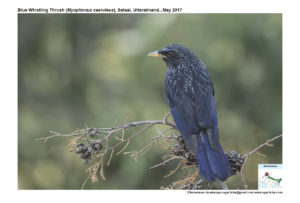Blue Whistling Thrush

Blue Whistling Thrush Myophonus caeruleus
Etymology:
- Myophonus : Greek word muia- fly; phoneus – slayer
- Caeruleus : Latin word fordark blue
Vernacular Names :Kash: Hazardastaan, Kasturaa, H.P: Kasturaa, Narel, Pun: Paharinilikasturi, Pahari: Kholchara, U.P.: Kuljel, Kaljit, Lepcha: Chamong-pho, Cachar: Di-daokatgashim, Daokatmeberung, Khasia: Simtung, Bhutia: Tetiman
Distribution in India: Resident of Himalayas and North East India.
Description: Size of 31-33 cm.The male of nominate race is bluish-black, upper body to rump covered with metallic violet-blue spots, with concentration from forehead to crown side. The lower body, wings and tail are deep dull blue, with a few silvery-grey spots on median upperwing-coverts. It has a concealed dull royal-blue shoulder patch. The eye is reddish, bill and legs are black. The female is similar to male but duller in colour.
Habitat: It is found in broadleaf evergreen and mixed deciduous forests and more open bush with scattered larger trees, commonly in gorges and ravines. It breeds at 1000–4000 m and winters from lowlands up to 2400 m.
Food habits : It eats Invertebrates such as water beetles, ants and other hymenopterans, cockchafer larvae, dung beetles, slugs, snails, crabs, froglets, earthworms, berries and seeds. . It is crepuscular. It feeds on damp ground, moving in long hops and turning over leaf litter, listening for movement, or picking its way along muddy margins and in shallow water; often forages along interstices of screes and talus, and digs vigorously in soft ground.
Breeding habits: They breed in Apr–Aug in Himalayas and is double-brooded throughout range. The nest is a bulky cup of green moss and muddy moss roots interwoven with fine grass, leaf stems and skeletons, tendrils and rootlets, placed on ledge in cliff or in overhanging bank, cave or crevice by rushing water, sometimes in tree fork, in old tree cavity, under bridge or on beam or rafter in isolated bungalow or temple. The nest may be reused in successive years but a new nest may be built for second brood. They lay a clutch of 2–5 eggs. The nest is brood-parasitized by Large Hawk-cuckoo.